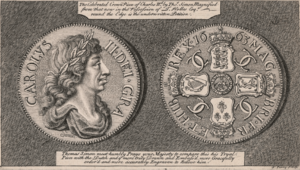Petition Crown facts for kids
| England | |
| Value | Crown |
|---|---|
| Mass | 33 g |
| Diameter | 40 mm |
| Composition | Silver |
| Years of minting | 1663 |
| Obverse | |
| Designer | Thomas Simon |
| Reverse | |
The Petition Crown is a very special coin made in 1663. It was designed by Thomas Simon, a famous English artist who created coins and medals. Simon gave this coin directly to King Charles II. It was like a personal 'petition' or request from him. He wanted the King to compare his coin with the ones made by the Roettiers brothers, who were from Flanders.
Simon also hoped the King would choose his designs for all future coins. This was important because new machines were now used to make British coins.
Contents
A Royal Coin Competition
There was a big competition to design these new machine-made coins. Thomas Simon and the Roettiers brothers, John and Joseph Roettiers, were rivals in this. For some reason, Simon didn't hand in his design on time. So, the Roettiers brothers won the competition by default. Their coins started being used in 1662.
But Simon really wanted to impress the King. So, the next year, he made this special coin. It looked very different from the Roettiers' coins. It also had his 'petition' (his special request) written around its edge in 200 letters.
The message on the coin's edge said:
-
THOMAS SIMON MOST HVMBLY PRAYS YOVR MAJESTY TO COMPARE THIS HIS TRYALL PIECE WITH THE DVTCH AND IF MORE TRVLY DRAWN & EMBOSS'D MORE GRACE; FVLLY ORDER'D AND MORE ACCURATELY ENGRAVEN TO RELEIVE HIM. [sic]
This means Simon was humbly asking the King to compare his coin with the "Dutch" (meaning the Roettiers brothers' coins). He hoped the King would see his coin was better designed and help him.
Protecting Coins from Clipping
Putting letters on the edge of coins started when Oliver Cromwell was in charge. Thomas Simon was already working at the Royal Mint (where coins are made) back then. These edge markings helped stop 'coin clipping.' Coin clipping was when people would shave off small bits of precious metal from the edges of coins. They did this to steal the metal for themselves.
At the time the Petition Crown was made, King Charles II's coins had a Latin phrase on their edge: DECVS ET TVTAMEN. This means 'An Ornament and a Safeguard.' This phrase was used on British coins until the pound coin was changed in 2015.
What the Coin Looks Like
Simon's coin shows a picture of King Charles II. The King has long, flowing hair and laurel leaves on his head. You can even see a famous "lovelock" of hair over his right shoulder. The engraving is so detailed that you can even see the shadows of the King's veins on his neck! The writing on this side says CAROLVS II. DEI. GRA. This is Latin for "Charles II, by the Grace of God."
On the other side of the coin, there are four shields with crowns. These shields represent England, Scotland, Ireland, and France. In the middle, you can see the symbol of the Order of the Garter. There are also two interlinked 'C's (for Charles) in each corner.
The back of the coin is slightly curved outwards (convex). The front of the coin, with the King's face, is slightly curved inwards (concave). This was done to make the King's image stand out more. Even though Simon's coin was amazing, the Roettiers brothers continued to make the dies for the crowns. However, from 1664, they made some small changes to their designs, probably because of Simon's influence.
A Rare and Valuable Coin
The Petition Crown is very rare and highly sought after by coin collectors, called numismatists. The first known sale of Simon's coin was in 1742. It sold for £20, which would be about £2,300 today! Over the years, its price has changed a lot. It sold for as little as £6.6.0 in 1795 and £500 in 1889.
Today, only a few of these coins are known to exist. Because they are so rare and beautiful, they are extremely valuable. Sometimes, copies of the coin, called electrotypes, have been made. These allow collectors who can't afford an original to still have a replica.
In 2007, an original Petition Crown sold for £207,100 (about $420,000). This set a new world record for a British silver crown at the time. More recently, in 2018, another example sold in New York for $649,000!
In February 2023, the UK's Royal Mint announced something exciting. They would release new commemorative coins inspired by the 1663 Petition Crown. This celebrates 360 years since the original coin was made.
Reddite Crown
Thomas Simon also used his coin dies to make a similar coin called the 'Reddite' Crown. The only difference between the Petition Crown and the Reddite Crown is the writing on the edge. The Reddite Crown's edge says:
-
REDDITE QUÆ CÆSARIS CÆSARI
This Latin phrase means "Render unto Caesar what is Caesar's."
On March 27, 2014, a Reddite Crown sold in London for £396,000 (about $657,000). This set a new world record for any British silver coin!
Images for kids



